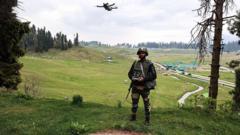As drone warfare emerges in the longstanding India-Pakistan conflict, both nations accuse each other of launching attacks using drones and missiles, heightening tensions in the region. Experts warn that this new phase of warfare may alter the conflict's landscape, complicating the dynamics between the nuclear-armed neighbors.
New Age of Warfare: Drone Escalation in India-Pakistan Conflict

New Age of Warfare: Drone Escalation in India-Pakistan Conflict
The India-Pakistan rivalry intensifies as both nations engage in unprecedented drone warfare, signaling a precarious shift in military tactics.
The world's inaugural drone war has become a reality in the South Asia conflict between nuclear-armed rivals India and Pakistan. Recent days have seen an escalation as India accuses Pakistan of launching drone and missile strikes on military bases within Indian territory and Jammu and Kashmir. Pakistan, in response, asserts that it has successfully intercepted and downed a significant number of Indian drones. This mutual exchange of unmanned aerial attacks is raising alarms among military experts and international observers, who note that the conflict has entered a perilous new stage.
Jahara Matisek, a professor at the US Naval War College, highlights the significance of this development, stating, "The Indo-Pak conflict is moving into a new drone era - one where 'invisible eyes' and unmanned precision may determine escalation or restraint." He emphasizes that nations adept in drone warfare will likely shape outcomes on the battlefield.
Reports indicate a severe toll on both sides, with Pakistan claiming recent Indian strikes have resulted in up to 36 fatalities, while India cites at least 16 civilian deaths linked to Pakistani shelling. The heated exchanges follow previous tension exacerbated by a militant attack that India claims was orchestrated by Pakistan, a claim Islamabad denies.
Pakistan's military has publicly stated it has countered 25 Indian drones across various urban centers, utilizing both technology and weaponry to down these aircraft. Meanwhile, India claims to have neutralized several Pakistani air defense systems, a narrative met with denial from Islamabad. This tit-for-tat drone exchange signals a marked shift toward unmanned warfare, which military analysts argue could redefine operational strategies in the region.
Drones play a crucial role in modern combat, capable of conducting reconnaissance, directing airstrikes, and supporting ground operations. India's drone fleet, largely supplied by Israel, has evolved significantly, utilizing sophisticated UAVs like the Harop, which can serve dual roles as both reconnaissance and loitering munitions for precision attacks. In contrast, Pakistan boasts a diverse array of drones from various nations, including China and Turkey, enhancing its military capabilities.
Experts note that while the recent drone exchanges between the rival nations signify a serious escalation, they do not reach the widespread drone warfare seen in the ongoing Russia-Ukraine conflict. Rather, the use of drones may reflect a restrained military option in the escalating tensions, as both sides continue to rely on traditional airpower alongside UAVs.
Defense analysts express that this ongoing conflict could serve as a prelude to greater military action, with a potential that either signals de-escalation or leads to heightened aggressions. The ramifications of this technology on a battlefield traditionally defined by manned aircraft raises strategic challenges for both nations.
Matisek stresses that while drones lower the threshold for military action and provide new tactical options, they equally introduce new dynamics of escalation—a reality underscored by any drone's neutralization. As the situation develops, the international community watches closely, aware that the stakes are profoundly high in this volatile region.



















